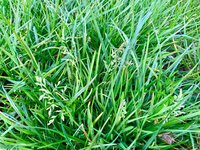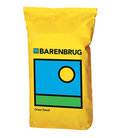Bar Tech
Welcome to the latest BarTech with thoughts, tops tips and advice from the UK Grass Experts on grass and herbal leys for livestock, arable and the environment.
Welcome to the latest BarTech with thoughts, tops tips and advice from the UK Grass Experts on grass and herbal leys for livestock, arable and the environment.
Annual meadow grass (Poa annua) is the nightmare of the grassland farmer. It is one of the most common grass species, but also one of the weakest. It is generally an annual but can occasionally be biennial or a short lived perennial. Fertile and acidic soils favour annual meadow grass and it will grow to altitudes of 1200m (almost 4000ft).
A plant can produce seed up to eight times per year which is the only survival mechanism of this species. Each plant can produce up to 100 seeds which can survive in the soil for over 5 years.
The plant is low yielding, has limited roots, no wear tolerance and a poor response to Nitrogen (only 17%) meaning it is very inefficient and poor for the environment. It is also sensitive to diseases and has poor winter and summer hardiness.
 Annual meadow grass is usually easy to identify although the plants can vary in height from 5 – 30cm tall. The youngest leaf will emerge in a folded shape and the leaf blades are often ‘puckered’ and always hairless. The tip of the leaf is boat shaped. There are no auricles at the base of the leaf and the ligule is long, rounded and milky-white. The leaves are often pale green in colour making it clearly visible in a field. Annual meadow grass can also be easily identified by its abundant seed formation which will occur all year. The seeds have no awns.
Annual meadow grass is usually easy to identify although the plants can vary in height from 5 – 30cm tall. The youngest leaf will emerge in a folded shape and the leaf blades are often ‘puckered’ and always hairless. The tip of the leaf is boat shaped. There are no auricles at the base of the leaf and the ligule is long, rounded and milky-white. The leaves are often pale green in colour making it clearly visible in a field. Annual meadow grass can also be easily identified by its abundant seed formation which will occur all year. The seeds have no awns.
The ligule is the easiest way to differentiate annual meadow grass from rough stalked or smooth stalked meadow grass. Rough stalked meadow grass has a long pointed ligule whilst smooth stalked meadow grass has a very short ligule.
Because annual meadow grass has many weaknesses, we can exploit these by using other grass species and specific varieties to overcome any challenges and lessen the risk of annual meadow grass invasion.
Annual meadow grass is basically a seed shedding opportunist. Where a gap appears in a sward, Poa seeds will take an opportunity to germinate and fill that gap. By maintaining optimal soil fertility and structure and a good grassland management plan using mixture appropriate to the demands of the farm, the desired plants will thrive and reduce the risk of weed ingression.
By maintaining a sward of productive, nitrogen responsive grasses, fertiliser use efficiency is maximised making your grassland enterprise both efficient and environmentally friendly. Using Nitrgoen well is not bad but applying to a field of annual meadow grass would be a poor choice both economically and environmentally as 83% of it would be wasted.
Annual meadow grass is very drought susceptible, so using mixtures such as BARMIX or NUTRIFIBRE on light, drought prone soils in low rainfall areas will help. These mixtures contain drought tolerant species such as our increasingly popular Soft Leaved Tall Fescues and modern Cocksfoot which are also productive and palatable. Using species more tolerant of drought can ensure swards are heathy and productive and lessen risk of annual meadow grass ingression. These species also have extensive root systems which will help build soil organic matter, stabilise soil and bring nutrients and moisture from lower in the soil profiles.
Annual meadow grass is also very susceptible to grass diseases so in areas where grass disease pressure are known, make sure to use species and varieties which more resistant to those diseases. Doing this will ensure better sward health and reduce the risk of annual meadow grass filling any gaps. Appropriate soil fertility and nutrient management planning is also crucial in disease prone areas to improve grass resilience.
Annual meadow germinates at 8OC soil temperature, so one approach is to establish species which germinate and grow at lower soil temperatures. Italian ryegrasses germinate down to 4OC but are more difficult to manage and may not suit your system. Hybrid ryegrasses, particularly perennial type ones such as BANNFOOT are an ideal compromise as this variety performs very similarly to a perennial ryegrass but with lower germination temperature and a yield advantage over a true perennial.
Perennial species such as perennial ryegrass, timothy and tall fescue also germinate at the same soil temperature as annual meadow grass so encouraging a dense sward is the key. Using diploid ryegrass varieties helps because these grasses have more seeds per kilo resulting in more plants per m2. These plants also have the genetic potential to produce 60% more tillers per plant than their tetraploid counterparts. Timothy is a very small seeded species; up to 4 million seeds per kilogram, so even a little on the mixture can promote ground cover.
Ideally, a new sward of perennial grasses would be grazed within its first 12 months. Allowing light to get to the base of the plants actively encourages the plants to tiller and improve sward density. Shutting up for silage blocks out light and prevents this from happening which can result in more open swards.
Using the Barenbrug Good Grass Guide would be an excellent way to identify a field with an annual meadow grass problem. Where there are gaps, but still a reasonable proportion of good, productive grasses (perhaps a Grass Index 3 field), overseeding would be a good option.
Mixtures such as Barmix RENEW are specifically designed to be used in overseeding situations, where seed is added to existing plants to fill gaps and restore the field to full productivity.

A blend of red clover varieties, to optimise performance across a variety of environmental and management conditions.

Mineral efficiency, soft leaves, digestibility, effective fibre and drought tolerance.

PROTA PLUS is a versatile mixture of clover and grass. High yields of high quality Italian ryegrass.

Lucerne combines good digestibility with high protein.
Discover our range of grass, forage, clover, herb and legume mixtures for the agriculture sector.
Discover our range of grass, forage, clover, herb and legume mixtures for the agriculture sector.
Discover our range of grass, forage, clover, herb and legume mixtures for the agriculture sector.